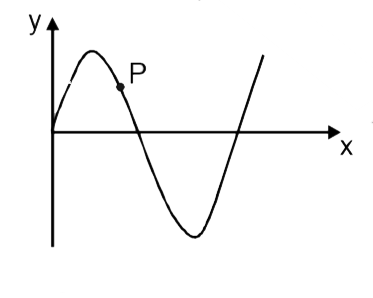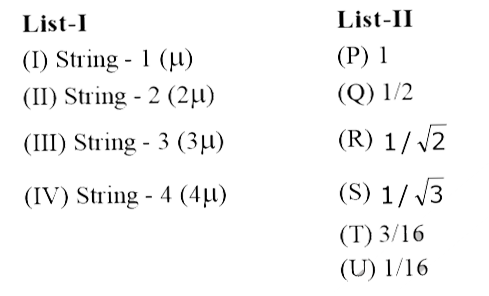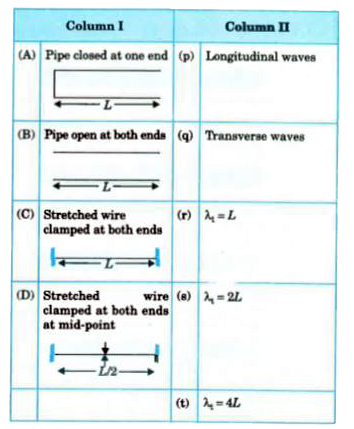MATRIX MATCH TYPE QUESTIONS from MODERN PUBLISHERS PHYSICS (HINGLISH) WAVES for Class 11
| Class 11 | PHYSICS |
| Chapter | WAVES |
| MODERN PUBLISHERS PHYSICS (HINGLISH) | MATRIX MATCH TYPE QUESTIONS |
| Medium | English |
| Academic Year | 2023-2024 |
Question 4
In a sonometer experiment, two wires are fixed whose tensions are in the ratio of 4 : 1, lengths in the ratio of 29 : 26 and diameter are in ratio of 2 : 1 and densities are in ratio of 4 : 5. What will be the frequency of beats produced if the frequency of note of higher pitch is 400 s−1 ? View SolutionQuestion 8
A motor bike is initially at rest. It then starts and further accelerates by 3 m/s3. At the rest position or at the starting point of motion there is a loud strong and stationary electric siren. What will be the distance travelled by the bike if the biker hears the siren frequency at 80% of its value when the bike was at rest. Speed of sound = 340 m/s. View SolutionQuestion 9
Towards a stationary object, a train is moving with a speed of 300 m/s and emits a sound wave of frequency 2000 Hz. Small percentage of the sound is reflected back to train in the form of echo. The frequency of the echo as detected by a person sitting in the train will be (speed of sound is 340 m/s).View SolutionQuestion 15
A train moving with a velocity of 18 km/hr blows a whistle which is heard by a motor cyclist driving with speed of 6 km/h with the frequency received as 200 cps. The actual frequency when train and motor cyclist are moving in opposite directions and approaching towards each other will be (Speed of sound is 340 m/s, cps is cycle per second) View SolutionQuestion 26
A tuning fork vibrating at frequency 800 Hz produces resonance in a resonance column tube. The upper end is open and the lower end is closed bythe water surface which can be varied. Successive resonances are observed at lengths 9.75 cm, 31.25 cm and 52.75 cm. Calculate the speed of sound in air from these data.View SolutionQuestion 38
A tuning fork is used to produce resonance in glass tuve. The length of the air column in the tube can be adjusted by a variable piston. At room temperature of 27∘C two succesive resonance are produced at 20 cm and 73 cm column length. If the frequency of the tuning fork is 320 Hz. the velocity of sound is air at 27∘C is View SolutionQuestion 41
A train moving at a speed of 220ms−1 towards a stationary object emits a sound of frequency 1000 Hz. Some of the sound reaching the object gets reflected back to the train as echo. The frequency of the echo as detected by the driver of the train is (speed of sound in air is 330ms−1)View SolutionQuestion 43
When two tuning forks (fork 1 and fork 2) are sounded simultaneously, 4 beats per second are heard. Now some tape is attached on the prong of the fork 2. When the tuning fork are sounded again, 6 beats per second are heard. If the frequency of fork 1 is 200Hz, then what was the original frequency of fork 2 ?View SolutionQuestion 46
Two cars A and B are moving away from each other in opposite directions. Both the cars are moving with a speed of 20ms−1 with respect to the ground. If an observer in car A detects a frequency 2000 Hz of the sound coming from car B, what is the natural frequency of the sound source in car B? (Speed of sound in air =340ms−1)View SolutionQuestion 47
A heavy ball is mass M is suspended from the ceiling of a car by a light string of mass m(m<<M). When the car is at rest, the speed of transverse waves in the string is 60ms−1. When the car has acceleration a, the wave-speed increases to 60.5ms−1. The value of a, in terms of gravitational acceleration g, is closest to: View SolutionQuestion 51
Two sitar strings A and B playing the note 'Dha' are slightly out of tune and produce beats of frequency 5 Hz. The tension of string B is slightly increased and the beat frequency is found to decrease to 3 Hz. What is the original frequency of B, if the frequency of A is 427 Hz?View SolutionQuestion 52
A motor cycle starts from rest and accelerates along a straight path at 2m/s2. At the starting point of the motor cycle there is a stationary electric siren. How far has the motor cycle gone when the driver hears the frequency of the siren at 94% of its value when the motor cycle was at rest ? (Speed of sound = 330ms−2)View SolutionQuestion 53
While measuring the speed of sound by performing a resonance column experiment, a student gets the first resonance condition at a column length of 18cm during winter. Repeating the same experiment during summer, she measures the column length to be xcm for the second resonance. Then View SolutionQuestion 62
Two wires W1andW2 have the same radius r and respective densities p1andp2 such that p2=4p1. They are joined together at the point O, as shown in the figure. The combination is used as a sonometer wire and kept udner tension T. The point O is midway between the two bridges. When a stationary waves is set up in the composite wire, the joint is found to be a node. The ratio of the number of antinodes formed in W1toW2 is-
 View Solution
View SolutionQuestion 65
A transverse sinusoidal wave moves along a string in the positive x-direction at a speed of 10 cm/s. The wavelength of the wave is 0.5 m and its ampli- tude is 10 cm. At a particular time t, the snap-shot of the wave is shown in figure. The velocity of point P when its displacement is 5 cm is Figure :
 View Solution
View SolutionQuestion 66
A hollow pipe of length 0.8m is closed at one end. At its open end a 0.5m long uniform string is vibrating in its second harmonic and it resonates with the fundamental frequency of the pipe. If the tension in the wire is 50N and the speed of sound is 320ms−1, the mass of the string is View SolutionQuestion 72
In an experiment to measure the speed of sound by a resonating air column, a tuning fork of frequency 500 Hz is used. The length of the air column is varied by changing the leavel of water in the resonance tube. Two successive resonances are heard at air columns of length 50.7 cm and 83.9 cm. Which of the following statements is (are) true?View SolutionQuestion 78
Two loudspeaker M and N are located 20m apart and emit sound at frequencies 118Hz and 121Hz, respectively. A car is intially at a point P, 1800m away from the midpoint Q of the line MN and moves towards Q constantly at 60km/hr along the perpendicular bisector of MN. It crosses Q and eventually reaches a point R, 1800m away from Q. Let v(t) represent the beat frequency measured by a person sitting in the car at time t. let vP, vQ and vR be the beat frequencies measured at locations P,Q and R, respectively. The speed of sound in air is 330ms−1. Which of the following statement (s) is (are) true regarding the sound heard by the person? View SolutionQuestion 86
Two trains AandB moving with speeds 20m/s and 30m/s respectively in the same direction on the same straight track, with B ahead of A. The engines are at the front ends. The engine of train A blows a long whistle.
Assume that the sound of the whistle is composed of components varying in frequency from f1=800Hz to f2=1120Hz, as shown in the figure. The spread in the frequency (highest frequency - lowest frequency) is thus 320Hz. The speed of sound in still air is 340m/s.
(4) The speed of sound of the whistle is View SolutionQuestion 87
Two trains AandB moving with speeds 20m/s and 30m/s respectively in the same direction on the same straight track, with B ahead of A. The engines are at the front ends. The engine of train A blows a long whistle.
Assume that the sound of the whistle is composed of components varying in frequency from f1=800Hz to f2=1120Hz, as shown in the figure. The spread in the frequency (highest frequency - lowest frequency) is thus 320Hz. The speed of sound in still air is 340m/s.
(4) The speed of sound of the whistle is View SolutionQuestion 88
Two trains AandB moving with speeds 20m/s and 30m/s respectively in the same direction on the same straight track, with B ahead of A. The engines are at the front ends. The engine of train A blows a long whistle.
Assume that the sound of the whistle is composed of components varying in frequency from f1=800Hz to f2=1120Hz, as shown in the figure. The spread in the frequency (highest frequency - lowest frequency) is thus 320Hz. The speed of sound in still air is 340m/s.
(4) The speed of sound of the whistle is View SolutionQuestion 97
Assertion : The apparent frequency will remain same as the frequency of source of sound if source and listener move at right angles to each other.
Reason : Apparent frequency will always increase whether source is moving towards the listener or listener is moving towards the source. View SolutionQuestion 98
Assertion : The fundamental frequency of a stretched string is directly proportional to the square root of the tension in the string if length and mass of the string are constant.
Reason : There are n nodes and n antinodes forms when standing waves are formed in a stretched string. View SolutionQuestion 100
List-IList-IIPSource and listener are moving in same1.Longitudinal wavesdirection with same velocity.QSource and listener are moving away from2.Apparent frequency increaseseach other.RSource is moving towards the listener at rest3.No change in frequencySSound waves in air4.Apparent frequency decreasesView SolutionQuestion 102
A musical instrument is made using four different metal strings, 1, 2, 3 and 4 with mass per unit length
μ,2μ,3μand4μ respectively. The instrument is played by vibrating the strings by varying the free length in between the range
L0and2L0. It is found that in string-1
(μ) at free length L0 and tension T0 the fundamental mode frequency is f0 .
List-I gives the above four strings while list-II lists the magnitude of some quantity.

If the tension in each string is T0, the correct match for the highest fundamental frequency in f0 units will be - View SolutionQuestion 103
Column IColumn II(A)For a stationary wave(p)Vibrations are perpendicular to direction to wave propagation(B)For a longitudinal wave(q)Amplitude of vibrations changes with time(C)For a transverse wave(r)Amplitude of vibration does not change with time(D)For a progressive wave(s)Vibrations are along the direction of wave propagation(t)Nodes and antinoes are formedView SolutionQuestion 105
Column I shows four systems, each of the same length L, for producing standing waves. The lowest possible natural frequency of a system is called it fundamental frequency, whose wavelength is denoted as λt. Match each system with statements given in Column II describing the nature and wavelength of the standing waves.
 View Solution
View SolutionQuestion 106
Two men are walking along a horizontal straight line in the same direction. The man in front walks at a speed 1.0 ms−1 and the man behind walks at a speed 2.0ms−1. A third mad is standing at a height 12m above the same horizontal line such that all three men are in a vertical plane. The two walking men are blowing identical whistles which emit a sound of frequency 1430 Hz. The speed of sound in air is 330 ms−1. At the instant, when the moving men are 10 m apart, the stationary man is equidistant from them. The frequency of beats in Hz, heard by the stationary man at this instant, is View SolutionQuestion 116
A stationary source is emitting sound at a fixed frequency f0, which is reflected by two cars approaching the source. The difference between the frequencies of sound reflected from the cars is 1.2% of f0. What is the difference in the speeds of the cars (in km per hour) to the nearest integer ? The cars are moving at constant speeds much smaller than the speed of sound which is 330ms−1. View SolutionQuestion 117
A train S1, moving with a uniform velocity of 108 km/h, approaches another train S2 standing on a platform. An observer O moves with a uniform velocity of 36 km/h towards S2, as shown in figure. Both the trains are blowing whistles of same frequency 120Hz. When O is 600 m away form S2 and distance between S1 and S2 is 800 m, the number of beats heard by O is ....... [Speed of the sound = 330 m/s]
 View Solution
View SolutionQuestion 118
A stationary source emits sound of frequncy f0 = 492 Hz. The sound is reflected by a large car approaching the source with a speed of 2 ms−1. The reflected signal is received by the source and superposed with the original. What will be the beat frequency of the resulting signal in Hz ? (Given that the speed of sound in air is 330 ms−1 and the car reflects the sound at the frequency it has received.)
0123456789View Solution
All Exercises from MODERN PUBLISHERS PHYSICS (HINGLISH) Class 11 PHYSICS WAVES
- PRACTICE PROBLEMS
- CONCEPTUAL QUESTIONS
- NCERT ADDITIONAL EXERCISES
- NCERT EXEMPLAR PROBLEMS
- NCERT TEXTBOOK EXERCISES
- HIGH ORDER THINKING SKILLS & ADVANCED LEVEL
- REVISION EXERCISES
- ASSERTION REASON TYPE QUESTIONS
- INTEGER TYPE QUESTION
- MATCHING TYPE QUESTIONS
- MATRIX MATCH TYPE QUESTIONS
- MULTIPLE CHOICE QUESTIONS
- CHAPTER PRACTICE TEST
- EXAMPLE
- PROBLEM